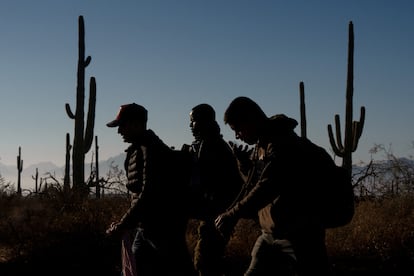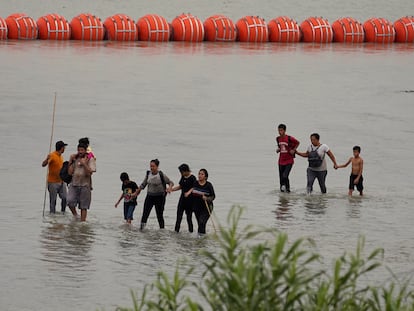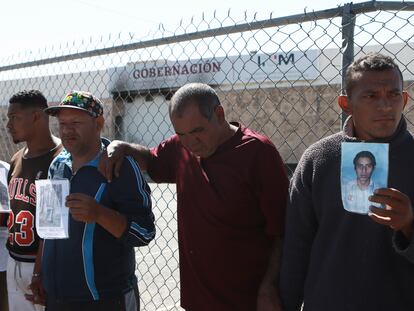US-Mexico border records one of its deadliest years ever
The death toll at the world’s most dangerous land crossing threatens to surpass the 560 victims documented last year


A 20-year-old woman’s trip north ended tragically in September. Border Patrol agents found her “face down in the sand” at 10 a.m. near a New Mexico highway. The coyotes (human traffickers) who had taken her into the United States had abandoned her the night before. The woman was taken to a hospital, where she died three days later in an intensive care unit. In August, the intense Texas heat dehydrated a Mexican man so badly that he suffered seizures and had trouble breathing. He died hours later. A 20-year-old Honduran man drowned in the Rio Grande in the summer, near where Texas authorities had installed a controversial floating wall of buoys to reduce the flow of migrants.
These are just some of the recently documented deaths of migrants. The deaths are discreetly reported by the local press, with the victims often remaining anonymous. The bodies are difficult to identify because migrants do not take their papers on the last leg of the trip to the U.S. A boy who drowned in the river was identified by his tattoos. His mother, who was waiting for news in a shelter in Mexico, was the one who identified him when agents showed her photographs. These stories come in trickles, but they make up a sea of casualties on the U.S.-Mexico border in 2023, which threatens to become one of the deadliest.
The El Paso Sector of the U.S. Customs and Border Protection (CBP) said a few weeks ago that 148 deaths had been recorded during the fiscal year 2023, which runs from October 2022 to the last day of September 2023. The figure nearly doubles the 71 deaths recorded in fiscal year 2022, which saw a significant influx of migrants. According to authorities, most of the deaths occurred between May and September, when high temperatures are recorded in the vast semidesert area stretching from El Paso in West Texas to the borders of New Mexico and Arizona.
The 148 deaths do not include those recorded in other Border Patrol sectors, such as Tucson (Arizona), San Diego (California) and the River Valley, another area of Texas that has recorded an influx of migrants. It has been a bloody year for a sector that documented six deaths in 2017. The 2023 crisis has also seen a significant rise in the number of female victims, with 84 recorded. In 2021, by contrast, there were 35. These figures may increase, as they are preliminary.
The deaths recorded in the El Paso sector represent a considerable percentage of those in 2021, the most recent official figures. That fiscal year, there were 560 deaths along the more than 1,800-mile border, according to CBP.
The year has set a new record for irregular crossings, with more than 2.4 million migrant interceptions recorded in 2023, The increase in the migratory flow has triggered a tug-of-war between Washington and Mexico. The two governments will address the issue on Wednesday in yet another high-level meeting. The crisis has also sparked a dire humanitarian situation that continues to deteriorate.
The United Nations has described the U.S.-Mexico border as the deadliest land route for migrants. It stated that last year, 686 immigrants died or disappeared in their attempt to reach the North American power. Almost half of these deaths are linked to crossings in the Sonoran and Chihuahua deserts — increasingly dangerous routes in an increasingly hot world. When the deaths from other legs of the journey are taken into account, such as the passage through the Darién jungle and sea routes through the Caribbean, the figure rises to 1,457 deaths. That makes 2022 the deadliest year in U.N. records.
But the international agency warns that the real number of victims may be higher. “The 2022 figure is likely higher than the available information suggests, due to missing official data, including information from Texas border county coroner’s offices and the Mexican search and rescue agency,” the International Organization for Migration (IOM) of the U.N. stated in September. In 2020, the University of Texas agreed with the IOM, stating that CBP data was incomplete, as it does not include the deaths of migrants who drown in the Rio Grande and whose bodies end up on the Mexican side. The academic report stated that more than 3,200 migrants have died trying to cross into south Texas since 1990.
Pending more recent official figures, the numbers are worrying. Throughout 2022, the Mexican consulate in San Diego documented 42 deaths of Mexicans trying to cross through Tijuana. Two years earlier, only 16 had been recorded in that area. Accidents and deaths increased in that area next to Donald Trump’s border wall. During the Trump administration, the wall went from being 5.1 to 9.1 meters high, which led to more hospital admissions for fractures, injuries and blows. Eight out of every 10 migrants who arrived at the hospital blamed their injuries on Trump’s wall.
Sign up for our weekly newsletter to get more English-language news coverage from EL PAÍS USA Edition
Tu suscripción se está usando en otro dispositivo
¿Quieres añadir otro usuario a tu suscripción?
Si continúas leyendo en este dispositivo, no se podrá leer en el otro.
FlechaTu suscripción se está usando en otro dispositivo y solo puedes acceder a EL PAÍS desde un dispositivo a la vez.
Si quieres compartir tu cuenta, cambia tu suscripción a la modalidad Premium, así podrás añadir otro usuario. Cada uno accederá con su propia cuenta de email, lo que os permitirá personalizar vuestra experiencia en EL PAÍS.
¿Tienes una suscripción de empresa? Accede aquí para contratar más cuentas.
En el caso de no saber quién está usando tu cuenta, te recomendamos cambiar tu contraseña aquí.
Si decides continuar compartiendo tu cuenta, este mensaje se mostrará en tu dispositivo y en el de la otra persona que está usando tu cuenta de forma indefinida, afectando a tu experiencia de lectura. Puedes consultar aquí los términos y condiciones de la suscripción digital.
More information
Archived In
Últimas noticias
Most viewed
- Reinhard Genzel, Nobel laureate in physics: ‘One-minute videos will never give you the truth’
- Oona Chaplin: ‘I told James Cameron that I was living in a treehouse and starting a permaculture project with a friend’
- Pablo Escobar’s hippos: A serious environmental problem, 40 years on
- Charles Dubouloz, mountaineering star, retires at 36 with a farewell tour inspired by Walter Bonatti
- Why we lost the habit of sleeping in two segments and how that changed our sense of time










































